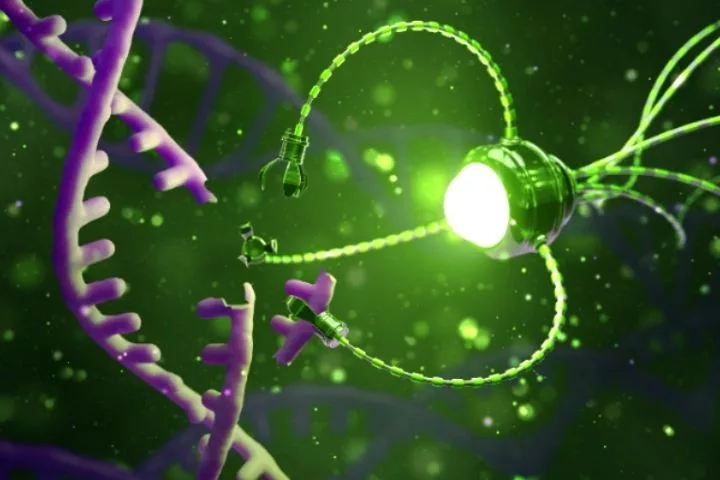Know About The Nanotechnology And Its Modern Applications

What is nanotechnology?
If you don’t use the term too narrowly, only the name and today’s possibilities are new to nanotechnology. On the other hand, humans have been using nanoparticles, i.e. the finest particles that cannot be seen even under very good light microscopes, for a very long time.
Modern architecture, new surface structures, and technical requirements due to climatic changes place new tasks on the coating material of facades.
In addition to the properties that used to be the focus of attention concerning the purely physical properties such as water absorption and water vapor diffusion capacity, additional parameters have been gaining importance for a long time when selecting the facade colour.
Among other things, visible dirt flags on the facades refer to the issue of the tendency of a face to become soiled or the facade coating.
With the increase in intensive tints and at the latest with the appearance of BFS Leaflet No. 26, colour stability is also in focus. In developing the most modern-day, facade paints are also used with nanomaterials, which can decisively improve the properties of a facade paint due to their special properties.
One speaks of nanotechnology when one of the relevant dimensions is smaller than 100 nanometers (abbreviation: nm, 1nm = 10 -9 m). This can be illustrated as follows: 1 nanometer is related to a meter like the diameter of a 1 euro cent coin to the earth’s diameter. This latest technology combines the advantages of dispersion, dispersion silicate and silicone resin facade paints.
New hype or old hat?
Around three millennia ago, the Egyptians used soot particles to produce ink that was only approximately 20 nanometers or, in other words, 20 billionths of a meter in size. In the Middle Ages, red-coloured glass for church windows was made with “nano-fine” gold particles.
And as early as the 1920s, car tires were coated with tiny particles of amorphous carbon, making them more efficient. It was only with the onset of “nano euphoria” that products that had long been on the market were given the prefix “nano”.
But what is it about nanotechnology, and what triggers the current popularity of the topic? First of all, it has to be clarified what nanotechnology is. Generally speaking, nanotechnology deals with structures that are less than 100 nanometers or 0.1 millionths of a meter in size.
These dimensions can no longer be represented by a traditional light microscope but can only be visible to the human eye with modern, high-performance electron microscopes. This already gives a large part of why nanotechnology, in the narrower sense, is a result of our modern times.
Although nanoparticles existed earlier and humans used them more or less specifically for their purposes, it was the relatively new technological developments such as the scanning electron microscope that created the conditions for further technological advances in the realm of the dwarfs (“nano” from ancient Greek “dwarf” “).
In these dimensions, the properties of materials sometimes change radically: substances that normally do not conduct electrical current can be excellent conductors in the nano dimension, chemically non-reactive substances can become highly reactive, colour, hardness etc., are different from our materials Perceptual world.
This is because the surface of nanoparticles increases gigantically compared to their mass, and there are many more atoms on this surface, which can make the material much more reactive.
Another decisive aspect of nanomaterials’ behaviour compared to larger material units is that on the level of individual molecules and atoms, the physical laws of our visual world give way to quantum physical effects.
Nanotechnology cannot be assigned to a single discipline such as chemistry or physics. Rather, it is an umbrella term or a platform for many applications and products that are developed across disciplines.
SI-Fusion is the latest facade paint development from Dinova.
In addition to silicone resin technology, nanotechnology has also been integrated. Inorganic, nanoscale sol-silicate particles are used in the binder, which “mineralize” the entire coating film and its surface during the drying process.
Thermoplasticity, a common cause of surface contamination, in which the influence of sunlight makes the coating surface soft and sticky, can thus be reduced considerably employing “mineralization” – as it were by the formation of a “protective shield”.
Without nanotechnology
How nanotechnology works in terms of reduced pollution
The latest technology with nanotechnology also aims – in contrast to the older silicone resin technology, in which a so-called “beading effect” was also desired on the surface and capillary hydrophobicity – while maintaining a strong, water-repellent effect of the coating film.
The background to this is that the “beading effect” is often only partial and uneven. That undesirable plumes of dirt can occur if the surface is damaged or water droplets remain standing and the coating swells.
Using nanotechnology, this is what happens when it is sprinkled SI-Fusion water hitting the coating surface homogeneously and very finely distributed. The facade is thus freed from dirt over the entire surface. The very thin water film can dry out very quickly, which also counteracts the formation of algae or fungal growth.
Nanotechnology in food: occurrence and labelling
Nanoparticles are tiny particles up to 100 nanometers in size, i.e. 100 billionths of a meter. Nanoparticles also occur naturally; they arise, for example, during combustion processes.
This small size can develop completely new properties or a far greater reactivity than the actual starting substance. The effects on human health for many nanomaterials have not yet been adequately researched.
Applications in nanotechnology, such as medicine, cosmetics, energy or computer technology, are being researched. Nanoparticles are already in use in many areas, including cosmetics, paints and packaging. If nanoparticles are used directly as ingredients in food, for example, additives, labelling is mandatory.
Since December 13, 2014, ingredients used in food in the form of “technically produced nanomaterials” must be labelled with “nano” in the list of ingredients. However, there are virtually no conventional ingredients that fall under this definition.
For some additives, the European Food Safety Authority (EFSA) is examining by 2020 whether they should be classified as nanomaterials and therefore labelled. These are:
- Titanium dioxide (E 171),
- Iron oxides and iron hydroxides (E 172),
- Silver (E 174),
- Gold (E 175),
- Silicon dioxide (E 551),
- Calcium silicate (E 552),
- Magnesium silicate (E 553a) and
- Talc (E 553b).
This test has already been completed for titanium dioxide. According to the definition of the European Commission, it does not count as “technically produced nanomaterial”, but it can contain up to 3.2 per cent randomly created nanoparticles.
Silicon dioxide contains nano-sized particles that combine to form larger particles. It is still unclear whether they should be classified as nanomaterial. Some suppliers of dietary supplements state that they add silicon dioxide or silica as nanomaterial. Outside of the field of nutritional supplements, hardly any foods with nano-labelling are known to date.
Nanomaterials that are to be added to food for the first time to give them new properties are considered “novel food” and must undergo an approval process.
So far, not a single nano-food has been approved on the European market. According to the current state of knowledge, there are no corresponding applications.
Nanotechnology is not subject to labelling.
Natural, random or process-related nanomaterials are not subject to labelling. This includes nanomaterials created when grinding flour or coffee, homogenizing fruit juices, or emulsifying fat.
Nanocapsules, such as those already used as a carrier for additives, vitamins or fatty acids, for example, in food supplements, do not belong to the nanomaterials subject to labelling. The size of the capsules is in the nano range, but they also occur naturally.
Since they have no novel properties, they are not classified as nanomaterials and are not subject to any authorization requirement. However, the material from which the capsules are made must be specified in the list of ingredients (e.g. emulsifier polysorbate / E432).
While nanotechnology plays a subordinate role in the food itself, technically manufactured nanomaterials are already approved for plastic packaging. They should, for example, better protect the packaged goods from UV radiation, from germs or from drying out.
The nanomaterials have to go through special approval procedures before they can be used in food packaging. Their use does not have to be marked.
Modern applications
There is no question that there is currently a “gold rush mood” in science, technology, and industry regarding the potential uses of nanotechnology. Hardly a day goes by without a message in the media praising the sheer unbelievable possibilities of nanotechnology.
Many of these possibilities, be it the solution of our energy problems or the targeted destruction of cancerous tumours using nanomaterials, are still a long way off.
Nevertheless, nanotechnology has already penetrated our everyday environment considerably, although it should be noted that “nano” is not everywhere where “nano” is on it.
The current products are usually not nearly as spectacular as the “nanovisions” often conveyed through the media. An important application of “nanoproducts” is already today in the material coating. This makes objects either scratch-resistant or self-cleaning (lotus effect).
Many sun creams contain nanoscale titanium dioxide as a protective shield against the sun’s UV rays. There are no refrigerators on the market whose inner surface is coated with “nanosilver” and has an antibacterial effect. “Nanosilver” has also been used in medicine for a long time as a coating for antiseptic wound dressings.
The first functional foods based on nanotechnologically developed containers, which bring active ingredients in the body to where they are needed in a more targeted manner or generally increase their bioavailability, are also already on the market.
And, last but not least, modern computer processors are often so small that, based on the definition above, they fall into the field of nanotechnology.
Opportunities and risks from nanotechnology and nanoparticles
There is no doubt that nanotechnology offers a wide range of possibilities and potentials for progress and improvements in our living environment. However, the use of such technologies is not without risks for people and the environment.
Some hazards have already been well investigated, as nanoscale particles occur naturally in forest fires or volcanic eruptions, for example, or trigger the occupational disease silicosis (dust lung) in mining.
With a view to the health effects of fine dust, which also contains nanoparticles, there is sufficient evidence of its harmfulness so that far-reaching legal measures, such as local driving bans for certain vehicles, are taken to protect people.
Lessor, nothing is known about the possible risks of newer nanotechnological developments that are already on the market or about to be launched.
Put, the technological advantage of nanoscale structures and particles, namely their tiny size, is also at their disadvantage when it comes to protecting the environment or health: They are so small that they form the natural protective shields of living beings such as skin, The intestines, placenta, blood-brain barrier or even cell walls and membranes can penetrate and thus lead to inflammatory reactions or far worse.
Another problem can arise from the changed physicochemical properties on the “nano-level”, such as the changed reactivity,
Because of nanotechnology, Toxicologists founded a new discipline, nanotoxicology, which urges caution when handling this technology because of nanotechnology. For example, in an animal experiment with fish exposed to small amounts of the smallest carbon particles, so-called C 60 fullerenes, it was shown that these particles damaged the brains of the animals.
Understandably, a possible hazard arises less from those nanoparticles present in a solid material composite, for example, as a surface coating, than from unbound, free nanoparticles, which can lead to exposure of humans and the environment.
Risk research is still in its infancy here and lags far behind the rapid development of “nanoproducts”.
Since December 2014, the EU Parliament has passed a labelling requirement for food that relates to the use of nanomaterials. According to the Food Information Ordinance, all foods containing nanomaterials must be clearly labelled from this point on.
The name of such ingredients is followed by the word “nano” in brackets in the list of ingredients. After cosmetics, food is the second group of products that must be labelled to whether they contain nanomaterials. However, nanomaterials can still be used in many other products, such as cleaning agents, building materials or clothing, without the consumer knowing.






